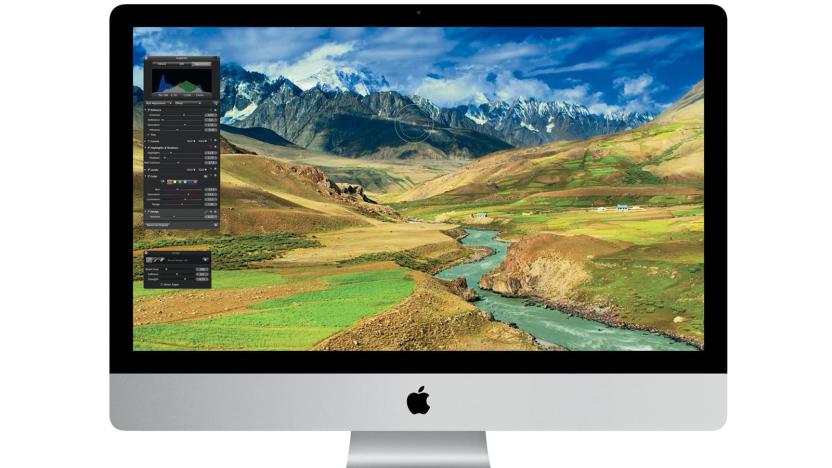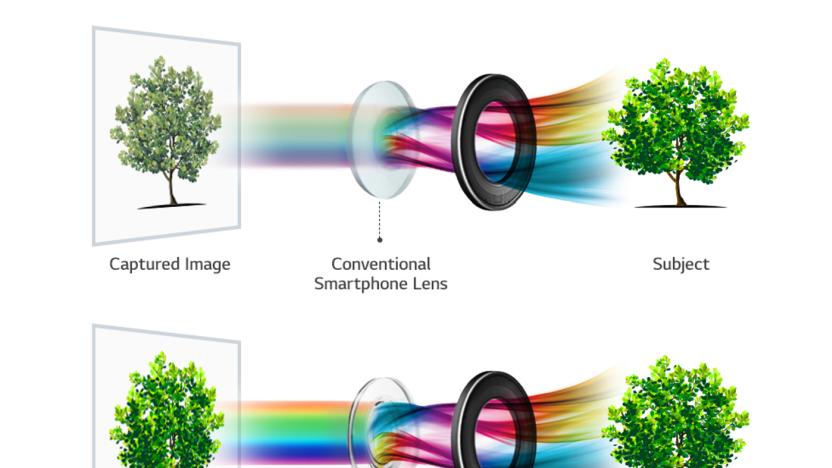aperture
Latest

Apple Aperture won't run in macOS after Mojave
You'll need a backup plan if you've been hanging on to Aperture years after its retirement. Apple has warned that its pro photo editing tool won't run in versions of macOS released after Mojave (that is, the upcoming 2019 release and beyond). If you want to access your Aperture libraries beyond that, you'll have to migrate them to either Photos or Adobe's Lightroom Classic. This isn't a total shock when Apple hasn't updated the software for five years (and hasn't even offered downloads in four years), but it could prove a headache if you've been deeply attached to Aperture's methods.

How to pick a lens for your mirrorless camera in 2019
When buying a mirrorless camera, there's an equally crucial side question: What lenses do I need for this thing? The glass you place in front of that sensor plays a key role in how your photos or videos look and what kind of shooting you can do. It's a complex decision too. You need to consider factors like sharpness, distortion, speed, prime or zoom and, most important, price. In this guide, I'll touch on all that and look at some of the best lenses for Sony, Canon, Nikon, Fujifilm and Micro Four Thirds mirrorless cameras.

Samsung's W2018 flip phone has a variable aperture camera
Smartphone makers are always pushing for the fastest-possible camera aperture, and until today, the record was held by LG V30 with its f/1.6 lens. But it didn't take long before Samsung hit back with an even lower f-stop. Earlier today, the Korean giant announced the W2018 which is its tenth extravagant dual-screen flip phone -- likely priced at above $1,500 -- made exclusively for China Telecom's "Heart Of The World" charity series. To our surprise, rather than simply repackaging existing flagship components into this form factor, Samsung actually threw in some new tech this time: not only does its 12-megapixel main camera come with an even lower f/1.5 aperture, but it can also switch to f/2.4 for a deeper depth of field when lighting is ideal.

LG V30's camera has the lowest f-stop in a smartphone
After focusing on audio for the V20, LG decided to shift its successor's selling point to something else: its camera. We still have a few weeks before V30's launch, but the phonemaker has followed up a leak of its hands-on footage with the revelation that the device will have the largest aperture on a smartphone yet. LG has incorporated an f/1.6 lens into the phone's dual camera -- as you might know, the lower the f value, the bigger the aperture is and the more the light gets in. An f/1.6 lens lets 25 percent more light in than an f/1.8 lens, for instance.

Here's what it's like to play Valve's VR 'Portal' experience
Sure, people can wax poetic about using HTC's Vive virtual reality headset, but what's it really like when you're looking through those lenses? You might not have to make a pilgrimage to one of HTC's tours to find out. ValveTime has posted a video walkthrough of Valve's Portal-themed VR demo (used on the Vive since this spring), and it gives you a good sense of what the immersive, room-based experience is like. To put it mildly, this is a tantalizing glimpse of what VR can do for gaming -- you can explore every nuance of an Aperture Science workshop, pulling drawers and levers almost like you were there. We don't want to spoil the whole thing, but it's safe to say there are robots and a few signature Valve surprises. Can we have a full-fledged title based on this, please?

Daily Roundup: New buyer's guide picks, betting with Cortana and more!
What's happening in the tech world today? Check out our updated Engadget buyer's guide to find the latest recommendations on laptops and tablets, then read about placing sports bets with Cortana and learn about Dell's latest portables. All that and more can be found below.

Heads-up: Apple will pull Aperture once Photos arrives
If you're determined to snag Aperture before Apple rides it into the sunset, you'd better do it quickly. Cupertino is now warning photo editing mavens that it's pulling Aperture from the Mac App Store once Photos is available this spring. You should still have the option of restoring your Aperture copy if you lose it, but there won't be a way to buy it if you decide that neither Photos nor Adobe Lightroom are your cups of tea. While the cutoff isn't all that shocking given Apple's historical eagerness to ditch older software as new versions roll out, it's not cheerful news if you were hoping that Aperture would stick around for a little while longer.

An edge-case perspective of Apple
Throughout the last decade, reading rumors about Apple products gave me an edge-case perspective of Apple. With each new rumor, I have an internal discussion that determines the validity with a "yes" or a "no." In the past couple years, the dialogue changed from "yeah, that would be cool" to "please, no." Unfortunately for me, my objections often go unaddressed as Apple heads in a direction I find unappealing. So why did that happen? Apple changed, but more realistically... I changed. Let's start with how I changed. Ten years ago, I was only eighteen and in the military. I bought an iPod Photo with my first credit card. I loved music and basked in it while studying for my military knowledge tests. A company called Apple filled this stressed out teenager's need for simplification with a portable music collection that I could fit in my pocket. I was impressed and kept watching Apple. Moving forward a few years, I was tired of carrying around my iPod and my LG flip phone. There was a short period where I tried the Motorola ROKR, but that was a terrible device with very little storage. Again, Apple stepped in and filled a need for simplification by introducing iPhone. During this era, I also picked up a Mac and fell in love with the creativity it allowed; for the first time, it seemed like the software stepped out of the way and I could just create. About the same time, Apple introduced the Apple TV, then the iPod touch, and finally iPad. None of those devices really filled a need for me. Sure, there's some convenience to having every Apple product in existence... but there's really no need for it. I have an Apple TV, an iPad, and an iPod touch now, but my iPhone and my Mac receive 90 percent of my daily attention. As I've aged, my needs changed, and my desire for new technology products has dwindled. (I'm more interested in seeing developers push the limits of our software, but that's not the point of this piece.) I'm constantly using my Mac for work, and my iPhone handles my free-time interactions. I bought my iPad mainly for reading, but I largely prefer a real book when given a choice. I bought my Apple TV for media sharing, but I don't have a cable or Netflix subscription so some of the built-in capabilities are useless to me. I bought my iPod touch for... well, I didn't actually buy it; one of my customers didn't want to fix it so I bartered other work and fixed it for myself. I haven't used it much. I apologize if I sound elitist here – in fact, most of my Apple devices are hand-me-downs from my repair company customers. For work, I have to stay well educated in the world of Apple; having a wide range of devices is crucial to my success as an Apple consultant. I always say that I know too much about Apple and how it thinks because there's no sense of mystery left for me. My friends call me "The Apple Guy" and often ask to chat about what they read on rumor sites. That would be awesome if I were more interested in the choices Apple makes. Examining Apple hardware Let's switch gears and talk about how Apple changed our hardware over the last ten years. They started with the iPod, its so-called halo effect, and increased Mac adoption. Shortly thereafter, they introduced the iPhone (and another halo effect for the Mac). I would consider all of these products revolutionary. Sure, the iMac in 1998 was amazing, but it really took the halo effect, Justin Long, and the switch to Intel processors to push the Mac back into the mind of the consumer. Since then, everything appears evolutionary to me. I do not discount the amazing progress we've seen in the capabilities of these devices, but they remain largely unchanged in scope. One can argue that the iPad was revolutionary – for a lot of people it was – but it only accounts for 10 percent of my usage. If you ask my wife, it's about fifty-fifty between iPad and iPhone; she doesn't use a computer outside of work. For some people, the iPad serves as their primary device. I think Apple's really targeting that demographic at this point. More on that thought in a bit. Examining Apple software Let's stop talking about hardware and address the software changes Apple introduced in the last ten years. The evolution of OS X is ongoing. In my industry, I cannot look at new software like candy and eat it immediately. Every recent dot release had major issues that hurt a lot of my customers... and I haven't seen it get better over the years. It's not worth discussing specifics here: they are irrelevant to this article, and they were very different depending on customer needs. The same things happen with major iOS updates; the biggest complaint is always battery life. Forget about the OS for a minute and think about the app updates released in the last few years. Apple consistently removes features from apps to help define the difference between consumer and prosumer or to create feature parity between Mac and iOS versions. iMovie and GarageBand seem largely worthless at this point because Apple wants you to upgrade to Final Cut Pro X and Logic Pro X. Aperture is dead in favor of an unreleased Photos app that assuredly focuses on consumers. iWork only recently updated to a usable app after Apple nerfed it last year; it's still not the powerhouse of old. The built-in creative capabilities of a brand new Apple device fail to exceed (they don't even compete with) those of my first generation MacBook. Instead, you have to rely on third-party – usually paid – software to fill in the gaps. Whether from Apple, Adobe, or another third-party developer, paid software is a must for anyone wanting to do something beyond the most rudimentary functions of the default software. However, most people would never notice the lack of creativity. I'm convinced that Apple knows this and changed its entire business model to reflect it. Realizing I'm not the focus Ultimately, I am an edge case. I want my devices to function in ways the average user would not. I want Apple to move into categories where their market research doesn't see profitability. Apple does not, and likely cannot, consider an edge case like me. My edge-case perspective of Apple doesn't align with its target demographic at this point. The first time I realized I was no longer Apple's primary focus was the introduction of Lion and its Server app. It crippled much of my business-related Mac use. I eventually switched to Ubuntu for most server-related activities, and I couldn't be happier. Still, Apple forced my hand by releasing terrible server software; that left a bad taste in my mouth. More recently, iOS 7 confirmed my suspicions that I wanted a different product than Apple wanted to create. Apparently, Apple's market research suggested that people wanted a freshly updated interface. In six years, we hadn't seen a major refresh to the iOS interface design. Some developers, like Tapbots, were taking strides to refresh the interface but Apple felt like it had to do something drastic to keep consumers interested in their products. During this time, we saw executive turmoil at Apple as Jony Ive took over interface design from Scott Forstall. I'm not arguing that skeuomorphic, minimalist, or flat design is better, but I will say that rushing a major redesign seems negligent. I still believe that iOS 7 was a regression in design and usability mostly because Apple pushed it out too quickly and left many consumers scratching their heads. Remember how bad the calendar app was in the initial release? It left many people scrambling to find an alternative like Fantastical. Yes, it's great for third-party developers, but doesn't this sound eerily familiar to the Mac app situation I mentioned earlier? Is the built-in value of Apple devices diminishing? The future looks edgy I'm afraid that Apple is pushing OS X 10.10 Yosemite in a similar direction. I know better than to criticize an unfinished product. I will however express concern about the timing of the release: I'm not sure Apple has enough time to fix all of the interface issues before the public release this fall. It feels rushed at this point. I want it to feel polished; I'm hoping they make the upgrade exciting instead of regrettable. From an iOS perspective, I'm excited for iOS 8 and the added APIs that will push the evolution of iOS forward. I can't wait for a TextExpander keyboard and a 1Password Safari extension. I still don't agree with some of the user interface choices, but it already seems more polished than iOS 7 ever did. The software coming to my truck looks appealing too. My CarPlay-compatible stereo is already installed and awaiting a firmware update from Pioneer and Apple. The upcoming Apple TV software update looks like an improvement, but it's still a far cry from what it should be. I often remind myself that the living room revolution is largely dependent on the cooperation of the television and movie industry. Without their support, Apple can't do much more in the living room... unless it produces a gaming console. Unfortunately, I think the company hopes to continue using the horsepower of your iPhone or iPad to generate large screen gaming. Desiring revolutionary products If Apple wants to revolutionize how we interact with our technology, CarPlay and Apple TV are where I wish they'd spend their time. I believe Apple could easily disrupt those industries with a little more effort, but I'm just an edge case. If rumors prove to be true, Apple seems more concerned with larger phones and smart watches at this point; that doesn't excite me. As I mentioned earlier, my favorite Apple products filled a need in my life. iPod, iPhone, Mac – those products simplified something for me. I'd really like to see Apple focus on filling a need we all share. Is a bigger screen on an iPhone going to do that? I don't think so; I'm not interested in a bigger screen. Can a smart watch fill a common need? I don't think so; I see too many drawbacks in a largely unproven category to consider it worthwhile. Biometric monitoring could certainly change lives, but that seems more like an edge case than a general need... at least to me. I also want to comment on the possible inclusion of sapphire glass in the next generation iPhone. It will be great for Apple, but it's terrible for clumsy phone users everywhere. Most people think the hardness of a material makes it less breakable. That's actually not true; sapphire is more scratch-resistant than gorilla glass, but it's also more brittle. Check out this video if you don't believe me. Ultimately, I want to eat these words on September 9th. I hope that whatever Apple introduces excites me as much as the first iPod or the first iPhone. Historically, Apple has seldom been first to market: MP3 players, smartphones, and tablets – those categories existed before Apple stepped in and obliterated the competition. Whatever they introduce on Tuesday, I want it to be more disruptive than their recent, evolutionary products. Continued Apple dominance Either way, Apple isn't doomed. Analysts and consumers seemed pacified after the release of iOS 7 simply because it was different. Apple shares are near an all-time high, no other company can touch their market cap, and the company has a ridiculous amount of money in the bank. My jaded perception of Apple's recent products hasn't meant a thing to its success because people keep buying them. If you share my sentiments, keep reminding yourself that the edge case rarely receives attention. Apple's target demographic doesn't mind having U2 at the keynote, likes bigger screens because the text is too small, and thinks watches are cool. I'm very far removed from that demographic at this point. Maybe someday my edge-case perspective will shift back into the mainstream. It would be nice to get excited again, wouldn't it?

The TUAW Daily Update Podcast for July 2, 2014
It's the TUAW Daily Update, your source for Apple news in a convenient audio format. You'll get some the top Apple stories of the day in three to five minutes for a quick review of what's happening in the Apple world. You can listen to today's Apple stories by clicking the player at the top of the page. The Daily Update has been moved to a new podcast host in the past few days. Current listeners should delete the old podcast subscription and subscribe to the new feed in the iTunes Store here. Note that due to out company holiday schedule, the Daily Update Podcast will not be available on July 3 or 4. We'll be back the afternoon of July 7 to bring you more Apple news in a hurry.

Apple details which Pro features from Aperture will be included in the new Photos app
Apple ruffled more than a few feathers last week when it indirectly announced that its upcoming Photos will mark the end of further development of Aperture, the company's professional photo editing software. While Apple's other pro-oriented software apps like Final Cut and Logic Pro will remain afloat, many professional photographers and enthusiasts alike were dismayed to hear Aperture will be going the way of the dodo. Of course, the silver lining, if one is inclined to look for one, is that we haven't yet seen what type of features Apple's Photos app might house. To that end, Ars Technica was able to get in touch with an Apple representative who helped shed a bit of light on what pro features we can expect to see in an Aperture-less world. When asked about what Aperture-like features users can expect from the new Photos app, an Apple representative mentioned plans for professional-grade features such as image search, editing, effects, and most notably, third-party extensibility. Also keep in mind that Aperture users will be able to seamlessly (we hope!) migrate their existing photo libraries to the new Photos app. The end of the line for Aperture updates, Apple tells Ars, will be to ensure that the software will be compatible with OS X Yosemite. Following that, it's Apple's new Photos app or bust.

The TUAW Daily Update Podcast for June 27, 2014
It's the TUAW Daily Update, your source for Apple news in a convenient audio format. You'll get some the top Apple stories of the day in three to five minutes for a quick review of what's happening in the Apple world. You can listen to today's Apple stories by clicking the player at the top of the page. The Daily Update has been moved to a new podcast host in the past few days. Current listeners should delete the old podcast subscription and subscribe to the new feed in the iTunes Store here.

Adobe releases a statement about the end of Aperture development
Earlier today Apple announced it has ceased development of the photography editing program Aperture. As photographers around the web deal with the news Adobe has released the following statement regarding the closing of its rival application. Today, Apple announced they will no longer be developing Aperture in light of their new photography app for OS X. If you are an Aperture or iPhoto customer looking for change, check out our new Creative Cloud Photography plan announced last week, or our standalone Lightroom app for your desktop as alternatives. The all new Creative Cloud Photography Plan gives you Photoshop (Mac / Win) and Lightroom (Mac / Win / iPhone / iPad / Web). This new offer not only addresses traditional desktop photo requirements but extends these workflows to the web and your mobile devices. Today, Lightroom mobile provides seamless access from desktop, tablet, phone and web. Put simply we're doubling down on our investments in Lightroom and the new Creative Cloud Photography plan and you can expect to see a rich roadmap of rapid innovation for desktop, web and device workflows in the coming weeks, months and years. We also continue to invest actively on the iOS and OSX platforms, and are committed to helping interested iPhoto and Aperture customers migrate to our rich solution across desktop, device and web workflows. Of course Adobe is another option for photographers but cost was always a consideration. Aperture was a one time purchase of $79.99. Adobe's Creative Cloud for Photography is $9.99 a month, or roughly $120 + tax, every year. We'll have to wait until Apple's new Photos app is released this fall to until we know exactly what its editing capabilities are, but it will likely not replace Lightroom for serious work.

Apple puts Aperture out to pasture, moving users to new Photos app
Apple's pro photo editing suite Aperture is coming to the end of its life. In 2005 Cupertino decided to take on the entrenched powers in that field, including Adobe, but clearly the company has decided there are better uses for its resources. Instead, with the next version of OS X, will be ushered towards a new app called Photos. Apple will even provide a tool for seamlessly moving your existing library to Photos. While it may pack some of the more advanced editing features of Aperture, the new app is actually aimed more at replacing iPhoto (which will also be getting the boot). Users that are unwilling to give up Aperture can rest assured that will provide compatibility updates for OS X Yosemite, but there will be no other changes to the software. For those that would rather move over to the Adobe family, there's always Lightroom, which is part of the Creative Cloud suite and has proven popular. Of course, that means paying a $10 monthly subscription. It's less than ideal, but at least Lightroom has a history of frequent updates. Update: This story originally stated that Apple was building a tool to aid those looking to transition to Lightroom. Instead the tool is for moving users to Photos. Apple is, however, working to provide documentation for those that wish to move to Lightroom.

Apple ceases development of Aperture
During this year's Worldwide Developers Conference, Apple briefly mentioned a brand new Photos app that will introduce editing tools and iCloud sharing. Today there's a bit of follow-up news, as Apple has confirmed it will cease development of Aperture, its professional photo-editing application. Apple provided the following statement to The Loop: With the introduction of the new Photos app and iCloud Photo Library, enabling you to safely store all of your photos in iCloud and access them from anywhere, there will be no new development of Aperture. When Photos for OS X ships next year, users will be able to migrate their existing Aperture libraries to Photos for OS. The Loop is also reporting that the forthcoming Photos app will also replace iPhoto, in an effort to create a continuous experience across every Apple device. The company's other pro editing apps like Logic Pro and Final Cut Pro will continue with development. R.I.P. Aperture, you served us well.

PhotoScope: Explore your iPhoto and Aperture libraries from your iPhone or iPad
It's always refreshing to see something new for photo aficionados and PhotoScope (US$4.99) certainly meets that criteria. PhotoScope gives you complete access to your Aperture and iPhoto libraries from any iOS hardware as long as all your devices are on the same WiFi network. To get things up and running, you download and run a free helper app for your Mac. Next, launch PhotoScope from iOS, and with a tap to select either iPhoto or Aperture libraries, you'll see your pictures arranged as they are on your Mac. All the albums and projects are named, and the metadata is also available to you. Photos can be emailed in large or small versions as well as copied, saved to your iOS camera roll, printed or tweeted. Images can also be copied and then pasted into other apps. PhotoScope supports flags and ratings, so you can remotely tag your photos (Aperture only) from your iPhone or iPad. Neither iPhoto nor Aperture needs to be running on your Mac for you to be able to browse photos. If you tag or modify image information, iPhoto or Aperture will launch as needed. Photos can be pinched and double-tapped to zoom in or out, and the app supports full resolution. PhotoScope is pretty handy, and unique in terms of its functions. I'd love to see the app support remote access and be able to talk to my Adobe Lightroom content. David Ritchie, the app developer, says remote access is being worked on, and requests for Lightroom compatibility and other features will certainly be considered. PhotoScope is a worthwhile app that will please many people who want the features the app offers. I actually found browsing my photos on my iPad to be faster and more enjoyable than sitting at my Mac. PhotoScope requires iOS 7 or later, and works fine on the iPhone, iPad and iPod touch. It is optimized for the iPhone 5.

Aperture updated to 3.5.1
OK, so it's not the biggest, most important update of the century out there. But those who work with Apple's pro-level photo cataloging and editing application -- Aperture -- will be happy to know that the company has posted an update to the app that's available on the Mac App Store's Updates tab. What does Aperture 3.5.1 bring to the photo-editing party? Face-detection overlays have been fixed so that they actually work properly, and an issue with metadata-field entry when arrowing between photos has been resolved. There's also a fix for Temperature and Tint White Balance, and Apple's favorite addition in fractional updates like this -- "stability improvements." If you're an Aperture user, get thee to your Software Updates posthaste!

Aperture 3.5 supports iCloud Photo Sharing, uses Apple Maps for Places
You can add one more thing to Apple's list of new hardware and software upgrade announcements: the latest iteration of Aperture. Version 3.5 brings a handful of new features to the OS X app, including iCloud Photo Sharing support that lets you access (or give access to) shared image or video streams. In addition to that, Aperture's Places feature now uses Apple Maps to pinpoint locations where photos are taken -- not a huge surprise considering OS X Mavericks has Cupertino's map app baked right in. The upgraded app can also recognize and support iOS 7 image filters, upload videos up to three minutes long to Flickr and sync with a SmugMug image hosting account. All these features come free along with a barrel of bug fixes, so long as you have Aperture version 3.0 -- otherwise, the app's available on iTunes for $80.

Aperture 3.5 released, adds iCloud photo sharing, Maps support + more
In addition to the other flurry of software releases today, Apple has released Aperture 3.5. The update includes a slew of bug fixes and small enhancements -- along with some pretty noticeable ones as well. Among the bigger enhancements: iCloud Photo Sharing is supported, Apple Maps is now used for Places, and support for publishing and syncing galleries directly to a SmugMug account has been added. The full release notes are below. Aperture 3.5 is a free download to those that have version 3.0 or higher. Users who don't own it can purchase it from the Mac App Store for US$79.99. What's New in Version 3.5 • Adds support for iCloud Photo Sharing, including the ability to post videos to shared photo streams and to have multiple subscribers contribute to a shared stream • The Places feature now uses Apple maps to display photo locations • New integration with SmugMug, with support for publishing and syncing galleries directly to a SmugMug account • Adds support for iOS 7 camera filters applied to photos imported from iOS devices • Fixes an issue that sometimes resulted in Retouch adjustments not being applied to exported images • Addresses an issue that could cause the black and white points in Curves to shift incorrectly when using the eyedropper tools • Fixes a problem that prevented caption data from being embedded correctly when exporting versions of some RAW file types • Improves reliability when adding names to Faces • Addresses an issue that could cause Aperture to hang after adjusting a very large panorama • Fixes a problem that could prevent memory cards or hard disks from ejecting properly after import when clicking the Delete Items button • Improves reliability of slideshows on a 15" Macbook Pro with Retina display • Addresses an issue that could cause thumbnails to display incorrectly in the iLife Media Browser • Videos up to three minutes long can now be shared to Flickr • Captions instead of version names are now synced between Aperture and Facebook for newly-created albums • Improves reliability when printing a light table • Fixes an issue that could prevent adjusted images from being published to My Photo Stream • Includes stability and performance improvements

Apple's love of 'Mavericks' has been around for a while
At this year's WWDC Apple previewed the latest version of OS X 10.9 named Mavericks. The name was a departure from its previous scheme of naming OS X after cats. As Phil Schiller noted in the keynote, Mavericks is a popular surfing spot in California that many Apple employees like to go to to catch a wave – and as we've noted, it's close to where Phil Schiller lives. An interesting little factoid about Mavericks (courtesy of keen eye reader Tyler G) is that this is not the first time Apple has used the name. Way back in 2005 the company spotlighted the Mavericks surfing spot in promo material for its then-newly released Aperture software. Surfing images from Mavericks, along with the locale's name, can be found as elements of custom-made Aperture books and also as contact sheets on the original web page announcing the features of Aperture.

Apple updates Aperture with import and memory card bug fixes
Apple has released a software update to its professional photo editing and management software, Aperture. The 3.4.5 update addresses the following issues, according to its release notes: Addresses an issue that could cause Aperture to quit unexpectedly when deleting items from a camera or memory card after import. Memory cards are now ejected correctly when using the Delete Items option after import. Includes stability improvements. Aperture 3.4.5 is a 523 MB download and requires OS X 10.7.5 or higher if you're running Lion and 10.8.2 or higher if you're running Snow Lion. Aperture costs US$79.99 in the Mac App Store.










